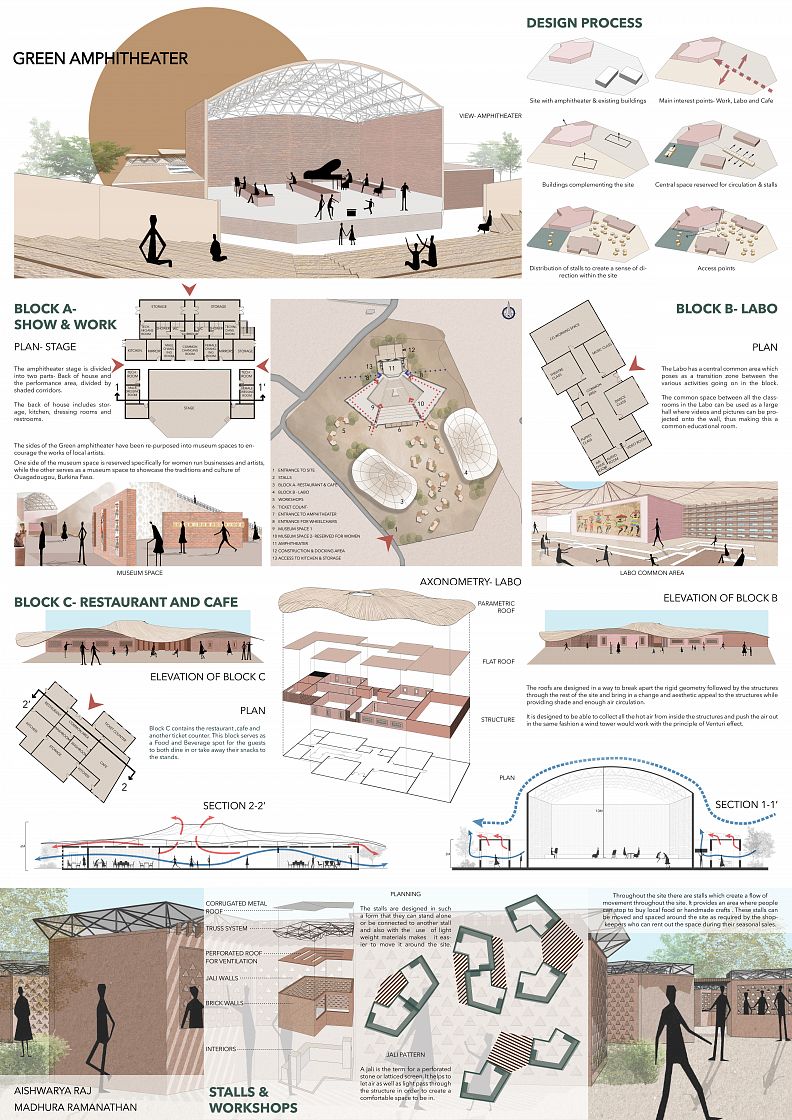The Hub

Project idea
The Green Amphitheater is designed to provide a platform for local artists to showcase their talents. The theatre is redesigned to extend the existing amphitheatre while adding cafe and restaurant spaces, stalls, workshops, classrooms and more. Burkina Faso Experiences some of the most extreme climate variations.
SUSTAINABILITY
The Amphitheatre design is developed to be responsive and adaptable to the climatic conditions while incorporating traditional and sustainable designs.
Clay is highly used in the traditional design as it is abundantly available in the region. The designs incorporate mud bricks arranged in patterns to facilitate ventilation and thermal protection against the hot climate. The design also uses bamboo which is easy to handle and construct while also being locally available.
Most spaces throughout the structures are designed to rely on natural light and ventilation through louvres and jail patterns, to conserve and reduce the dependence on artificial energy. The Labo workshops aim to educate the current and upcoming generations on sustainability and sustainable practices.
The space around the amphitheatre is converted into a museum space. One side of the museum space is reserved specifically for women-run businesses and artists, while the other serves as a museum space to showcase the traditions and culture of Ouagadougou, Burkina Faso. This hopes to give women and artists an opportunity to stimulate their skills and talents. The museum acts as a blank canvas to display their art.
We are graduate architects originally from India but based in the U.A.E, and our approach to this design was to incorporate design ideas and strategies we have seen in both India and have learnt being in the UAE. Together with the information and creativity, we give you THE HUB.
Project description
BLOCK A- Work and Show
The WORK and SHOW area is split into the 'back of house' and the performance area respectively. The stage is covered by a curved truss system to help with ventilation and overall air movement throughout the space.
The 'back of house' includes dressing rooms separate for men and women, kitchen, mirror rooms, restrooms with showers and storage spaces. The stage is accessed through corridors shaded with louvres. This allows for enough light to enter the corridor while avoiding direct sunlight. The construction and storage areas are placed at the back to be easily accessed by the service road at the back.
The sides of the Green amphitheatre have been re-purposed into museum spaces to encourage the works of local artists.
BLOCK B- LABO
LABO consists of classrooms for various activities for the children to learn be a part of. The rooms are placed in the periphery this creating a central transition space between them. This space poses as a small-scale theatre as it is stepped for seating. A projector is placed to be displayed on the wall.
BLOCK C- RESTAURANT AND CAFÉ
Block C houses the restaurant, cafe and additional ticket counters for the theatre. The restaurant and cafe are for the visitors and the locals in the area. Three interior walls are painted with the traditional art of the region. This is seen to educate the visitors and locals while providing the opportunity to small scale artists.
STALLS
There are stalls throughout the site which are meant to be leased to local artisans to create a commercial hub which helps the artisans showcase and sell their work. The stalls help distribute the public to the amphitheatre while directing them to focal points at the restaurant block as well as the Labo.
They are designed are singular components that can easily be dismantled. They can exist individually or be connected with other components which can be moved around the site as pleased.
LANDSCAPING
Plants are mainly placed around the ‘back of house’ stage to avoid overlooking into construction or docking area.
Several trees and shrubs are planted all around the site to improve the micro-climate of the area. Trees are mainly planted next to fenestrations to cool the air passing through it.
The trees and shrubs are planted to harness the benefits of the predominant easterly winds entering the site. With the use of locally grown trees and shrubs and relocation of existing plants on site helps provide shade and shadow while making this approach a sustainable one.
The landscaping program aims to introduce trees and vegetation, which in time will reinforce the surrounding soil against desertification. The other advantages are passive ventilation and help sustain the groundwater table.
Technical information
DESIGN
The walls of the buildings are designed to allow ventilation between the interior and exterior by having patterned perforations or JALI.
The word ‘jali’ stems from the Sanskrit word for ‘net.’ In the Middle East, jali’s are known by the Arabic word ‘Mashrabiyya. It later developed into windows, partitions, and screens and became an integral part of the architecture in the Middle east.
This has been adopted in the design as it serves as breathing walls for the buildings. Jali walls allow for the constant flow of air within the buildings. Furthermore, the buildings block B and C have parametric bamboo roofs with a central opening to direct and control the flow of air within the structure. Aimed to entrap the cool air within the rooms while the hot air being lighter rises above and escapes through the perforated roofs.
The parametric structure aims to avoid abstracting the oncoming winds whole directing it invested towards the building. The narrow central opening is higher hence enabling Stack effect to take place.
The rooms in the blocks have flat roofs with a truss system of either parametric bamboo roofs or angled metal corrugated sheets. This helps to avoid overheating of the interiors while also serving as a ventilation system.
The combination of the truss systems along with Jali and brick walls help to maintain the thermal comfort in the structure.









